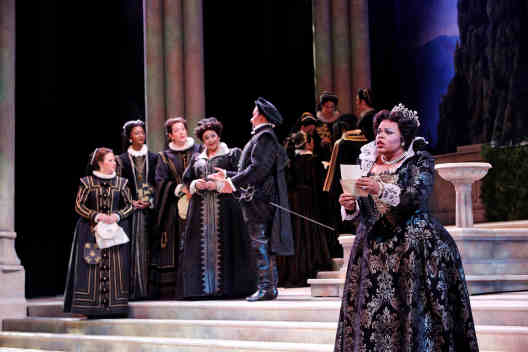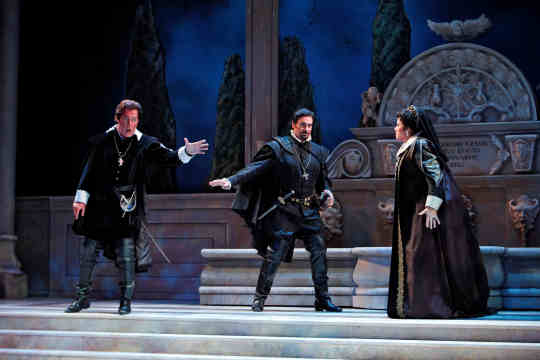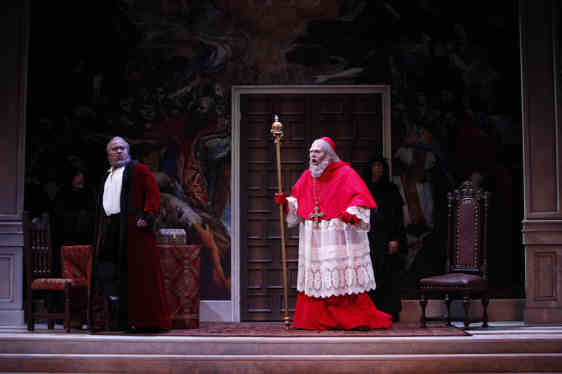Other Links
Editorial Board
-
Editor - Bill Kenny
-
Deputy Editor - Bob Briggs
Founder - Len Mullenger
Google Site Search
SEEN AND HEARD INTERNATIONAL OPERA REVIEW
Verdi, Don Carlos: Soloists, orchestra and chorus of Sarasota Opera, Victor DeRenzi (Conductor): Sarasota, Florida, 7.3.2009 (LS)
Production:
Director: Victor DeRenzi
Stage Director : Stephanie Sundine
Scenic Designer: David P. Gordon
Costume Coordinator: Howard Tsvi Kaplan
Lighting Designer: Ken Yunker
Wigs and Make Up Designer: Georgianna Eberhard
Surtitle Supplier:Words for Music
Surtitle Translator:Victor DeRenzi
Cast:
Philippe II, King of Spain:Kevin Short
Don
Carlos, Infante of Spain:Gustavo López Manzitti
Rodrigue, Marquis de Posa:Marco Nisticò
The
Grand Inquisitor:Jeffrey Tucker
A Monk:Benjamin Gelfand*
Elisabeth De Valois:Reyna Carguill
The Princess Eboli:Stella Zambalis
Thibault:Maria D'Amato*
A Celestial Voice:Jo Ellen Miller*
The Count of Lerme: Brandon McReynolds*
A Royal Herald:Matthew Giebel*
Flemish Deputies: Evan Brummel*, Matthew Hanscomb*, Bernard Holcomb*, Erik
Kroncke,*Michael Scarcelle*, Michael Ventura*
Don Carlos is felt by many to
be Verdi's greatest opera. It's big, bold,
and for the most part riveting. Even in its revised four act version
the performance with two intermissions takes four hours. And the
original five act version with ballet lasted even longer.
Act II begins in the Queen's Garden. Carlos speaks passionately with
whom he thinks is Elisabeth, but is in reality Eboli. When he learns
the truth, his behavior convinces Eboli that Carlos loves the Queen.
She swears revenge and departs. Rodrigue appears and asks for
Carlos' private papers.
The second scene of Act III takes place in prison. Carlos awaits his
fate. Rodrigue approaches and tells Carlos that he has saved him by
letting the authorities discover the incriminating papers given to
him in Act II. Rodrigue is now viewed as the traitor working on
behalf of Flanders and is shot by a member of the Inquisition. As he
confesses to Carlos and dies Rodrigue has not one but two arias--
C'est mon jour suprême and his death scene. The citizens storm the
prison, Eboli helps Carlos escape, and the Grand Inquisitor brings
down the curtain by restoring order.

Act I Scene 2
Its characters include a prince in love with his mother, a queen
torn between the love for her son and duty to her country, a nasty
yet moody and at times pitiful king, two betrayers who ultimately
reverse course, a blind Grand Inquisitor, a monk who may be a ghost,
and a celestial voice. All of this plus powerful confrontations,
glorious duets, arias and ensembles, massive choruses, beautiful
sets, and an authentic auto da fé,
When it was first performed in 1867 for the Paris Opera , the five
acts and ballet proved to be much too long. During the next 15 years
it was edited by different opera companies, until Verdi decided to
completely revise and shorten it. On January 10, 1884, a new four
act version in Italian translation from the French was performed at
La Scala. All of Verdi's revisions were to a French text, but most
subsequent performances have used the Italian translation. On March
7, 2009 Sarasota Opera became the first North American opera company
to stage Don Carlos in its uncut 1884 four act French language
version.
Act I opens with beautiful horns setting the stage for the grand
drama. The monks in the monastery of San Yuste pray for the late
Emperor Charles V and ask God for mercy. Carlos enters and sings his
only aria in which he recalls his love for Elisabeth and her
arranged marriage to Philippe . Rodrigue enters and Carlos confesses
that he still loves Elisabeth. Rodrigue is stunned --"your
mother!!"-- and advises Carlos to turn his attention to the
suffering people of Flanders. The scene closes with the famous
Carlos -Rodrigue duet "Dieu, tu semas dans nos ames" with each
swearing loyalty to the other.
Scene 2 introduces us to the scheming Eboli singing The Veil Song.
This is followed by a confrontation between Elisabeth and Carlos
arranged by Rodrigue. He asks her to petition Philippe to let Carlos
go to Flanders. He next reminds her of his love and she breaks off
the interview. Philippe enters and is furious when he finds
Elisabeth without her attendant. He banishes Elisabeth's attendant
which triggers the beautiful romanza O ma chère compagne in which
Elisabeth pours out her compassion and sorrow. Philippe then turns
to Rodrigue for a private discussion. Rodrigue asks that Flanders be
freed. Philippe listens and doesn't commit himself, but warns
Rodrigue to beware the Grand Inquisitor. He also tells Rodrigue that
Carlos is stealing Elisabeth's love.

Act II Scene 1
The second scene of Act II contains the famous auto da fé and the
confrontation between Carlos and the king. When the petitioners for
Flanders have been rebuffed, Carlos draws his sword vowing to save
the Flemish people. The king thunders for Carlos to be disarmed but
only Rodrigue steps forward to do so. Not surprisingly Carlos is
stunned by the betrayal. As the heretics are burned a voice from
heaven provides consolation.
Act III contains the first of four blockbuster arias allotted to
each of the principals but Carlos. Philippe's Elle ne m'aime pas is
one of the greatest arias in the bass repertory. A cello solo sets
the stage for what begins as the tragic recognition that Elisabeth
never loved him and ends with a hope that death will enable him to
finally sleep. The Grand Inquisitor arrives and Philippe asks
whether he should condemn his own son Carlos. The answer is clear.
The peace of the world is worth the blood of a rebel son. But the
Inquisitor goes on to say that Rodrigue also should be handed to the
Inquisition. The king says "never!" but the Grand Inquisitor hints
that the king might be in danger if he doesn't obey. The
confrontation between the two basses is one of the highlights of the
opera.
The action shifts to a scene between Elisabeth and Philippe. She
says her jewelry box has been stolen, but he shows her the box
containing Carlos' picture. He accuses her of adultery, she faints,
and Eboli is called in to assist Elisabeth. Eboli confesses to
Elisabeth that she stole the box, placed the picture, and for good
measure had been the King's mistress. Elisabeth is furious and
banishes Eboli, who, in turn sings the famous O don fatal where she
curses her beauty, but resolves to save Carlos.

Act III Scene 1
Act IV quickly brings the opera to an end. We are back at the
Cloister of San Yuste. Elisabeth sings her famous aria Toi qui su le
néant in which she says her work is over and hopes Carlos will go to
Flanders and forget her. She prays to Charles V that he should carry
her tears to God. Her heart seeks only the peace of the grave.
Carlos arrives and agrees that he should leave Elisabeth and free
Flanders. They bid each other farewell.
Philippe and the Inquisitor suddenly enter to execute Carlos, but
before they can act a figure emerges from the tomb and leads Carlos
in. Who is this figure? It is either A) the ghost of Charles V
taking Carlos to the grave or B) the living retired Charles V taking
Carlos into sanctuary at the monastery. The Sarasota opera program
chose alternative B, whereas I've always preferred alternative A .
Gustavo Lopéz Manzitti was a superb Don Carlos. His confrontation
scenes with Rodrigue, Elisabeth, King Philippe, and Eboli were
wonderful. His voice and acting were equally strong, although
perhaps he might have been a bit less overpowering in Act I. He
hails from Argentina where he has performed principal roles in
Rigoletto, Simon Boccanegra, and La clemenza di Tito at the Teatro
Colon de Buenos Aires.
Marco Nisticò was an excellent Rodrigue exhibiting a beautiful
baritone voice coupled with fine acting. He held his own with Lopéz
Manzitti in the famous loyalty duet and was very effective in his
Act III death scene.
Nisticò appeared last year in Sarasota singing Figaro in the Barber
of Seville and Francesco Foscari in I due Foscari. His credits also
include appearances at Caramoor, the Teatro Communale di Bologna,
and New York City Opera.
Bass-Baritone Kevin Short was small in stature but large in voice.
His poignant Elle ne m'aime pas was another of the evening's
highlights as was his confrontation scene with the formidable bass
Grand Inquisitor. Short is a favorite at Sarasota Opera having sung
principal roles in 1991, 2000, 2001, and 2003. He has also appeared
at the Metropolitan Opera, Houston Grand Opera, and Stuttgart Opera.
I've always imagined the blind Grand Inquisitor as emaciated and
frail whereas bass Jeffrey Tucker was perhaps a bit too healthy. His
voice however was right on the mark and he handled the difficult low
notes with ease. He is also well known at Sarasota having taken on
principal roles in 2003, 2006, 2007 and 2008.
Soprano Reyna Carguill replaced the scheduled Julianna Di Giacomo a
the last minute. She has a beautiful voice but was less comfortable
as an actress especially in the early parts of the production. She
also had a bit of a problem handing Toi qui su le néant in Act IV.
Nevertheless she certainly contributed to a wonderful night of
singing.
The role of Eboli is usually given to a mezzo soprano, but Sarasota
opera chose soprano Stella Zambalis. I recently acquired a 1990
Omaha Opera performance of Donizetti's Maria Padilla and there was
Zambalis as Ines-- with Rene Fleming singing Maria. Zambalis had a
fine voice then and it is excellent today, perhaps even more so as
it has matured. The aria O dan fatal is a show stopper and Zambalis
sang it with beauty and the appropriate emotion. Zambalis' credits
are extensive and include engagements at the Metropolitan Opera,
Houston Grand Opera, Deutsche Opera Berlin and Seattle Opera.
Each of the Studio Artists performed well, and special mention
should go to Monk/Ghost Benjamin Gelfand
The production itself was for the most part excellent and fast
paced, The four hours passed swiftly--in complete contrast to other
Don Carlo's such as those directed by Herbert Von Karajan. The sets
--particularly in the jail and monastery scenes-- were excellent as
were the costumes.
I was a bit disappointed by Act II Scene 2. I recognize that sets
can be costly, but the cathedral and its opening doors seemed a bit
too "cardboarderish" if there is such a word. I was also
disappointed by the auto da fé. There was simply no terror, and the
small stage was much too crowded for any special effects. Finally,
the celestial voice ending the Act didn't quite come off, perhaps
because of sound projection and acoustical issues.
As usual Victor DeRenzi and his orchestra were masterful. The cello,
horns, and brass contributions were particularly effective. The
choruses were fine, although the monks might have been a bit more
spooky.
All in all DeRenzis' Don Carlos was a triumph. He is well on the way
to completing a full Verdi cycle. Don Carlos was number 25. I hope
to see the 26th --Giovanna D'Arco scheduled for 2010
Lew Schneider
Pictures © Richard
Termine
Back
to Top
Cumulative Index Page
